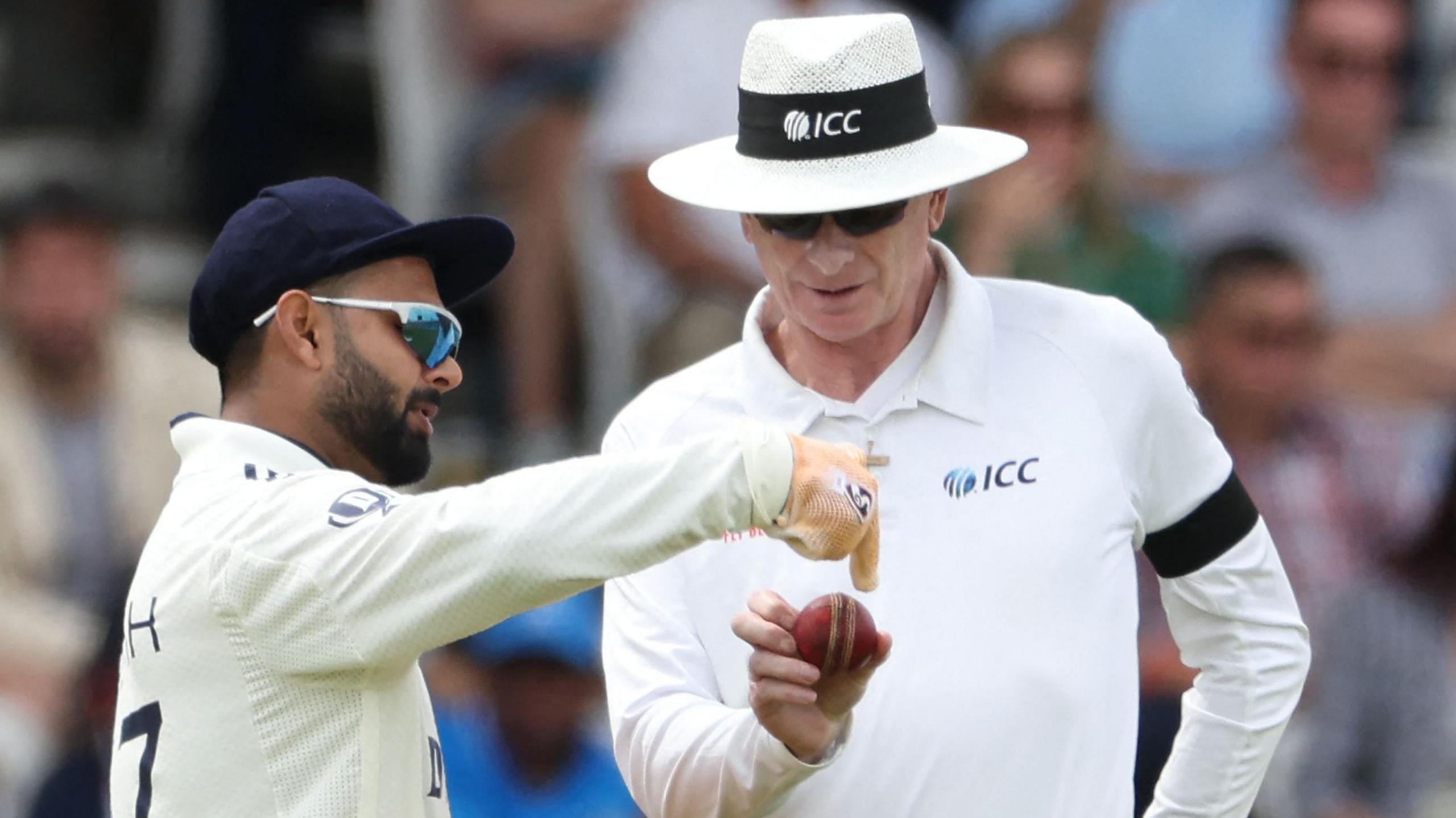- 464 Comments
After the first three Tests were troubled by issues, the manufacturer will examine the balls used in the series between England and India.
Due to their disconcerting wear and tear, the Dukes’ balls have been frequently changed.
By the end of the week, Dukes will receive as many used balls as possible from the England and Wales Cricket Board (ECB).
Owner of British Cricket Balls Ltd., Dilip Jajodia, told BBC Sport, “We will take it away, inspect, and then start talking to the tanner, talking about all of the raw materials – everything.”
What exactly is the issue?
The host board chooses the ball for test matches. The Dukes are played in England, while the Kookaburra is used in Australia and the Tests are played with a SG ball.
The Dukes, which have been in production since 1760, have long been regarded as a high-quality product, but there have been issues with Test and county cricket in recent years.
After 80 overs of an innings, the ball has been going soft, and taking wickets becomes more difficult when it goes soft. Bowlers claim that fielders’ edges are less compressed and that the pitch has not lost the same zip.
Data collected during the entire season is analyzed by the ECB’s Professional Game Committee and Cricket Advisory Group. As well as reports from captains and umpires, this would include the number of balls that had changed.
In recent years, discussions have been sparked by concerns about the quality of balls, and there are more instances of balls becoming softer more quickly. However, this problem only sporadically emerged during England’s third Test against India at Lord’s.
England’s first innings saw five ball changes, with one only changing after ten overs on the second morning.
Former England international bowler Stuart Broad argued that the cricket ball should be “like a fine wicketkeeper – barely noticed.”
The ball is a big deal to us, and it almost always gets changed because it is. Unacceptable .
What is the issue’s root cause?
The Dukes’ production process is still a traditional one.
Cork is still used to make them, is wound in string, is cased in leather, and is joined by a hand-stitched seam. Further variation is also made by dipping the cow hides in dye, which provides the leather.
According to Jajodia, there may be a number of factors at play.
One is the natural raw materials that need to be molded and assembled by a human being, he said.
The leather that holds the entire thing together is undoubtedly the most important component of a cricket ball, and if the fibers that make up the animal skin have a weakness or inherent issue, we can only discover it if it fails after thorough inspection and investigation.
Covid did have a very significant impact on various businesses, he continued.
“Personal behavior should change throughout the entire tanning process, regardless of whether they have passed away or deemed it to be too challenging.
Additionally, it might be that some of the chemicals are no longer available due to businesses closing down. The cattle themselves could be the culprits, or the processes could be.
There isn’t a choice because there is a tanner left that practically makes cricket ball leather. Working with the tannery is a must to ensure that they generally produce what you want.
Jajodia also thinks that the more recent game, which has bigger bats, more sixes, and more difficult playing surfaces, may be a contributing factor.
According to him, “the unique nature of cricket is that you can’t test that ball before it goes into play,” and that means that if it fails, it will fail in use and at its worst possible level in the glare of publicity.
JavaScript must be enabled in your browser to play this video.
What is possible?
According to Jajodia, who accepts that may not be popular, that a new ball should be given to the bowling sides should be done after 65 overs rather than 80 as a possible solution.
We’ve had three Test matches, he said, and they’ve all been good ones. They’ve been interesting games,” they said.
We shouldn’t be expecting drastic and dramatic changes, but rather, we should be cautious.
This product has been in existence since 1760. You can only go through the routine of everything you do and try to identify yourself because there is no quick fix for this.
Of course, the ECB has other options. Their agreement with Dukes is renewed on an annual basis, and they do not have a fixed contract with them.
In county 2nd XI cricket, Gunn & uses a hand-stitched ball. In the event that Dukes is ever required, one of the benefits of this is to provide a substitute.
The Kookaburra has been the subject of controversies since 2023 when it first appeared in the County Championship. The England team initiated this innovation to aid in bowlers’ overseas preparation.
An average of 1, 194. 66 runs were scored per match in the two rounds of Championship cricket that were already played this year using the Kookaburra, a significant increase.
The Kookaburra’s ineffectiveness in this country may be due to its preference for the softer pitches in the UK as opposed to the southern hemisphere’s harder surfaces.
“I can assure you that we are always on the case,” Jajodia said.
“I spend my entire life making these balls, and I personally choose the balls for each game,” he said. They are wonderful.
related subjects
- Cricket
Source: BBC

Leave a Reply